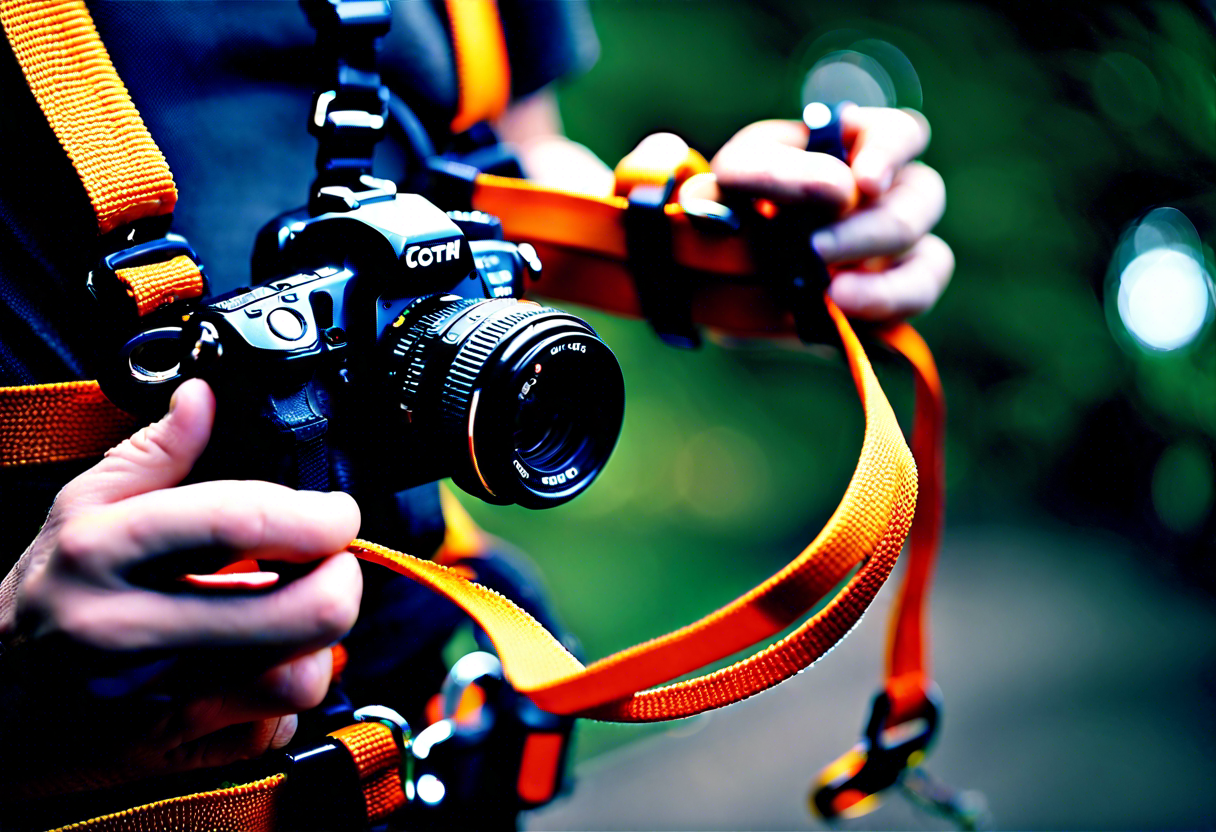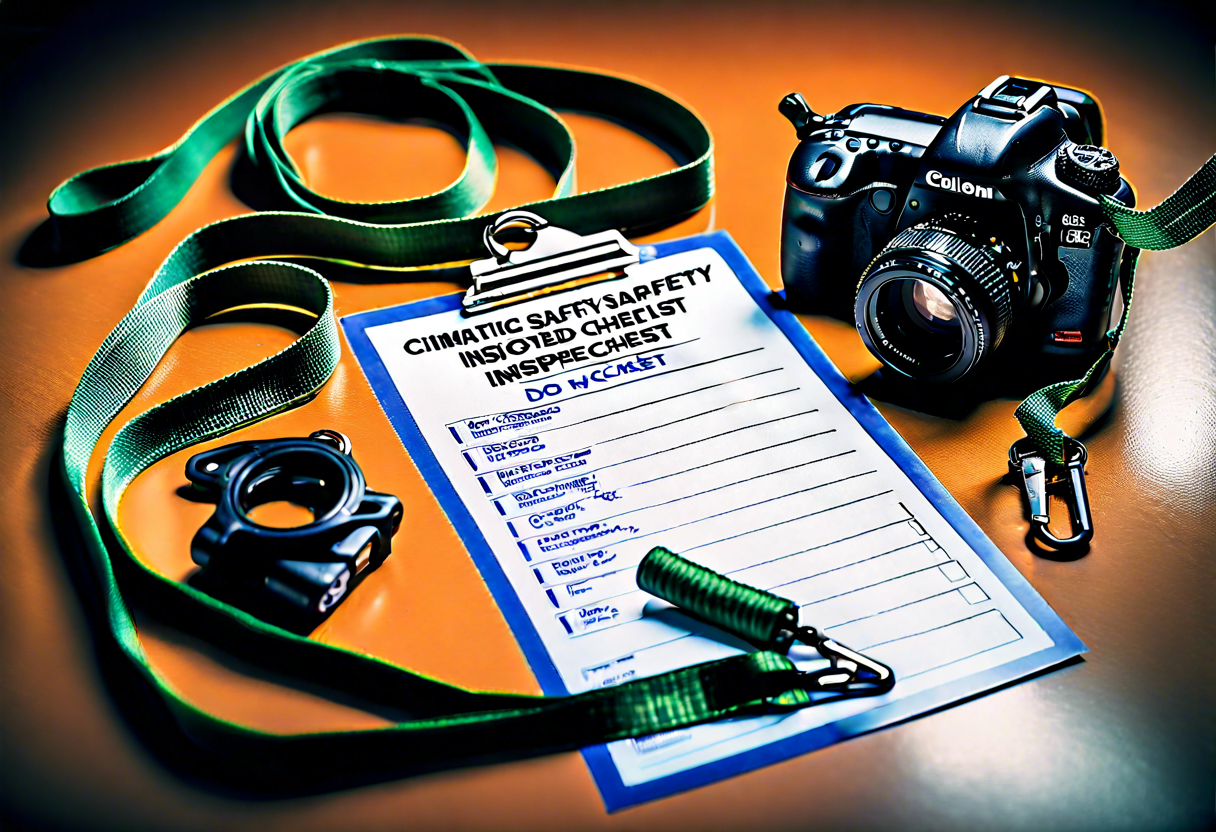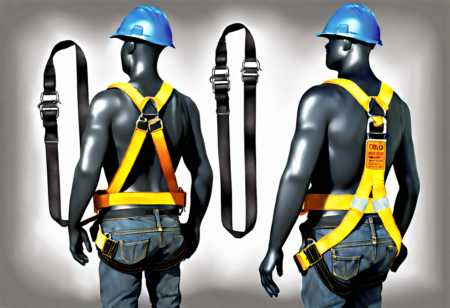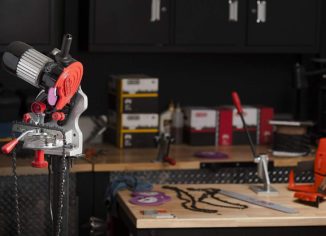Understanding the Basics: What is a Safety Harness and Lanyard?
A safety harness and lanyard are essential tools for ensuring the safety of workers who are exposed to heights or potentially dangerous areas. Whether you are working on a construction site, performing maintenance on a tall structure, or engaged in any activity where falls could occur, using a safety harness and lanyard is crucial to protect yourself from serious injuries or even fatal accidents.
A safety harness is a type of protective equipment that is worn on the body and is designed to prevent falls. It consists of straps and buckles that securely hold the wearer in place and distribute the force of impact across the body. The harness typically includes shoulder straps, leg straps, and a waist belt to provide maximum support and keep the wearer in an upright position during a fall.
On the other hand, a lanyard is a flexible rope or strap that connects the safety harness to an anchor point. The anchor point is usually a secure attachment, such as a fixed structure or a safety line. The lanyard acts as a lifeline, preventing the worker from falling or being pulled away from the anchor point.
Why are safety harnesses and lanyards important?
The main purpose of a safety harness and lanyard is to protect workers from falling and minimize the risk of severe injuries or fatalities. They provide a last line of defense in situations where other safety measures, such as guardrails or safety nets, may not be sufficient.
By wearing a safety harness and lanyard, workers can confidently perform their tasks at height, knowing that they are secured and protected. It gives them the freedom to move within their work area while maintaining a safe distance from the edge or potential hazards.
Furthermore, using a safety harness and lanyard is not only for the protection of individuals but also for the overall productivity and reputation of a company. It demonstrates a commitment to safety and compliance with relevant regulations, helping to create a positive work environment and avoid costly accidents or legal implications.
It is important to note that it is not enough to simply wear a safety harness and lanyard. Proper training and knowledge about how to use them correctly are essential. Workers must follow manufacturer instructions, inspect their equipment regularly for any signs of wear or damage, and use the appropriate harness and lanyard for their specific work environment and requirements.
In the next section, we will provide a step-by-step guide on how to properly put on a safety harness and lanyard to ensure maximum safety and protection.
How to Properly Put on a Safety Harness and Lanyard
Step-by-Step Guide for Wearing a Safety Harness and Lanyard
Putting on a safety harness and lanyard correctly is essential to ensure your safety while working at heights. Here is a step-by-step guide to help you properly wear a safety harness and lanyard:
- Select the Right Size: Before wearing a safety harness, ensure that you have the correct size for your body. A loose or tight harness can compromise your safety, so choose one that fits snugly and comfortably.
- Inspect for Damage: Thoroughly inspect the safety harness and lanyard for any signs of wear and tear, such as frayed straps, damaged buckles, or broken stitching. Using damaged equipment can be extremely dangerous, so always ensure they are in good condition before use.
- Put on the Harness: To put on the harness, slip your arms through the shoulder straps, making sure they are not twisted. Adjust the straps accordingly to ensure a secure fit. Fasten the buckles and tighten them snugly but not too tight. Ensure that all straps are properly adjusted to provide even weight distribution.
- Attach the Lanyard: Once the harness is securely worn, attach the lanyard to the designated D-ring on the back of the harness. The lanyard is a connecting device that keeps you secured to an anchor point. Double-check that the lanyard is in good condition and properly connected to both the harness and the anchor point.
- Inspect Anchor Points: Before using the anchor point, inspect it for any signs of damage or weakness. Ensure the anchor point is strong, stable, and capable of supporting your weight. Remember, using an unreliable anchor point can lead to a fall.
- Adjust Lanyard Length: Consider the nature of your work and choose the appropriate lanyard length. If you need more mobility, use a longer lanyard, but if you require less, opt for a shorter one. Adjust the lanyard accordingly to avoid excess slack, which can increase the risk of hitting a lower level in the event of a fall.
- Double-Check Proper Fit: Once everything is in place, double-check the fit of your safety harness and lanyard. Ensure that all straps are securely fastened and that there are no twists or tangles. Performing a quick self-check can provide peace of mind before commencing work.
Remember, proper training and familiarization with safety harnesses and lanyards are crucial. Always follow the manufacturer’s instructions, as the steps may vary based on the specific harness and lanyard you are using.
By following this step-by-step guide, you can confidently and correctly wear a safety harness and lanyard, reducing the risk of accidents and ensuring your personal safety while working at heights.
For more detailed information and illustrations on the correct usage of safety harnesses and lanyards, visit CompanyName.com to access their comprehensive guide.
Please note: The information provided here is for educational purposes only and should not replace professional advice or training. Always consult the manufacturer’s instructions and receive proper training before using any safety equipment.
Safety Tips and Best Practices for Using a Safety Harness and Lanyard
When working at heights or in potentially dangerous environments, using a safety harness and lanyard is crucial for protecting your life and minimizing the risk of falls or accidents. By following some essential safety tips and best practices, you can ensure that you are using your safety harness and lanyard effectively. Here are some guidelines to keep in mind:
1. Inspect Your Equipment: Before each use, carefully inspect your safety harness and lanyard for any visible signs of damage, such as frayed straps or worn-out buckles. If you notice any issues, replace the equipment immediately. It’s also essential to check that your harness and lanyard meet the necessary safety standards.
2. Properly Fit the Harness: A properly fitted safety harness is crucial for your safety. Adjust the straps according to your body size and shape, ensuring a snug fit without restricting movement or causing discomfort. Pay attention to the leg straps, waist belt, and shoulder straps to ensure they are properly adjusted.
3. Connect the Lanyard Correctly: When attaching the lanyard to the harness, make sure it is securely connected to an appropriate anchor point. Avoid using unsafe anchor points, such as pipes or temporary structures that may not hold your weight. Connect the lanyard to a reliable anchorage that has been certified for fall protection.
4. Maintain a Safe Distance from Edges: When working at heights, it’s crucial to maintain a safe distance from edges to prevent the risk of accidentally falling. Always stay at least six feet away from unprotected edges or openings. If necessary, install guardrails or safety nets in the area to provide an additional layer of protection.
5. Regularly Check and Retie Lanyards: During your work, periodically check your lanyard to prevent potential tripping hazards caused by excess slack. If you notice any looseness, promptly adjust and retie the lanyard. Be cautious not to create any loops or knots that may impede the effectiveness of the lanyard in the event of a fall.
6. Use Additional Fall Protection if Required: In certain situations, using a safety harness and lanyard alone may not provide sufficient protection. Consider using additional fall protection measures such as safety nets, guardrails, or personal fall arrest systems (PFAS) when working in areas with extreme heights or where the risk of falling is high.
7. Attend Proper Training: To effectively use a safety harness and lanyard, it is crucial to receive proper training. Understand the specific features, limitations, and usage guidelines provided by the manufacturer. Stay updated with any changes in safety regulations or equipment standards to ensure you are using the most appropriate techniques and equipment for your job.
By following these safety tips and best practices, you can use a safety harness and lanyard effectively, enhancing your protection against falls and ensuring a safer work environment. Remember, prioritizing safety is essential when working at heights or in hazardous conditions.
For more information on safety harnesses and lanyards, you can visit websites such as OSHA and NIOSH.
Please note that while these tips provide valuable guidance, it is essential to consult your employer’s safety regulations and follow their specific guidelines for using safety harnesses and lanyards in your workplace.
Understanding the Basics: What is a Safety Harness and Lanyard?
When working at heights, it is crucial to prioritize safety measures, and one of the most important tools for fall protection is a safety harness and lanyard. A safety harness is a piece of equipment designed to keep workers safe by distributing the force of a fall across the body, reducing the risk of injury. It consists of straps, buckles, and a connecting point for a lanyard. A lanyard, on the other hand, is a flexible line that connects the safety harness to an anchor point, providing a secure attachment and preventing falls.
Step-by-Step Guide: How to Properly Put on a Safety Harness and Lanyard
To ensure maximum safety and effectiveness, it is essential to know how to properly put on a safety harness and lanyard. Here is a step-by-step guide that will help you:
- Start by inspecting the safety harness for any signs of wear or damage. Check the straps, buckles, and D-rings for any fraying, corrosion, or deformation. If you notice any issues, replace the harness immediately.
- Open the waist belt and leg straps of the harness, ensuring they are fully extended and free of tangles.
- Put on the harness like a vest, sliding your arms through the shoulder straps. Make sure that the D-ring at the back is centered between your shoulder blades.
- Connect the waist belt and tighten it snugly around your waist, ensuring it sits just above your hips. Adjust the shoulder straps so that they are snug but not too tight.
- Adjust the leg straps to fit comfortably around your thighs, avoiding any discomfort or restriction of movement.
- Once the harness is securely fastened, move on to attaching the lanyard. Connect one end of the lanyard to the D-ring on the back of the harness, using a secure locking mechanism such as a carabiner.
- Identify a suitable anchor point and connect the other end of the lanyard to it, ensuring a secure attachment. The anchor point should be able to withstand the force exerted during a fall.
Safety Tips and Best Practices for Using a Safety Harness and Lanyard
Using a safety harness and lanyard properly is essential for ensuring the safety of workers at heights. Here are some safety tips and best practices to keep in mind:
- Always follow the manufacturer’s instructions for your specific safety harness and lanyard model.
- Regularly inspect your safety harness and lanyard for any signs of wear or damage. Replace any components that are worn-out or compromised.
- Only use safety harnesses and lanyards that meet relevant safety standards and regulations.
- Ensure that the anchor point is strong and secure. It should be capable of supporting the weight and force exerted during a fall.
- Maintain a safe distance from the edge when working near a fall hazard.
- Never attach the lanyard to an unstable or moving object.
- Avoid any potential hazards that may entangle or damage the safety harness and lanyard, such as sharp edges or corrosive materials.
- Consider additional fall protection measures, such as guardrails or safety nets, in conjunction with the use of a safety harness and lanyard.
By following these safety tips and best practices, you can effectively use a safety harness and lanyard to minimize the risk of falling and protect yourself while working at heights.
Common Mistakes to Avoid When Using a Safety Harness and Lanyard
While using a safety harness and lanyard is crucial for fall protection, there are common mistakes that should be avoided to ensure their effectiveness. Here are some of the most common mistakes to watch out for:
- Using an incorrect size or type of safety harness: It is essential to use a safety harness that fits properly and is suitable for the specific work environment.
- Failure to perform pre-use inspections: Neglecting to inspect the safety harness and lanyard before each use can lead to using faulty equipment, risking accidents.
- Improper attachment to the anchor point: Failing to connect the lanyard securely to a suitable anchor point can result in a fall.
- Inadequate training and lack of knowledge: Workers should receive thorough training on how to use safety harnesses and lanyards correctly.
- Failure to maintain and replace equipment: Safety harnesses and lanyards should be inspected regularly, and any damaged or worn-out components should be replaced promptly.
By avoiding these common mistakes and following the proper procedures and guidelines, workers can ensure the effectiveness of safety harnesses and lanyards in preventing falls and maintaining a safe working environment.
Frequently Asked Questions about Safety Harnesses and Lanyards
Q: How often should safety harnesses and lanyards be inspected?
A: Safety harnesses and lanyards should be inspected before each use and undergo a more thorough inspection at regular intervals, as specified by the manufacturer.
Q: Can safety harnesses and lanyards be reused after a fall?
Frequently Asked Questions about Safety Harnesses and Lanyards
When it comes to working at heights or engaging in activities that involve potential falls, safety harnesses and lanyards play a crucial role in ensuring the safety of individuals. However, many people have questions regarding the proper use, maintenance, and overall effectiveness of these safety devices. In this section, we will address some frequently asked questions to provide you with a better understanding of safety harnesses and lanyards.
1. What is the purpose of a safety harness and lanyard?
A safety harness and lanyard are designed to prevent falls and minimize the risk of injury when working at heights. The harness distributes the force exerted during a fall across the body, reducing the chance of serious injury. The lanyard, on the other hand, connects the harness to an anchor point, allowing for safe movement while still remaining securely attached to a stable structure.
2. How do I choose the right safety harness and lanyard?
Choosing the right safety harness and lanyard depends on the nature of your work and the level of protection required. Factors to consider include the type of activity, the height at which you will be working, weight capacity, and compliance with safety regulations. It is essential to select a harness that fits comfortably, has adjustable straps, and meets industry standards for safety.
3. How do I properly inspect and maintain my safety harness and lanyard?
Regular inspections and maintenance are crucial to ensure the integrity and reliability of your safety equipment. Before each use, visually inspect the harness and lanyard for any signs of wear, damaged stitching, or fraying. Check the buckles and connectors for proper functionality. Clean your equipment regularly with mild soap and water, and store it in a dry, well-ventilated area away from direct sunlight or chemicals.
4. How often should safety harnesses and lanyards be replaced?
Safety harnesses and lanyards should be replaced if they show any signs of wear, damage, or if they have exceeded their recommended service life. It is best to refer to the manufacturer’s guidelines for specific information on replacement intervals. Regularly check for visible signs of degradation, such as frayed straps, worn webbing, or broken hardware.
5. Can I reuse my safety harness and lanyard after a fall?
After experiencing a fall, it is important to retire and replace your safety harness and lanyard, even if there are no visible signs of damage. The stress exerted during a fall can compromise the structural integrity of the equipment, making it unreliable for future use. Your safety should always be the top priority, so invest in a new harness and lanyard to ensure optimal protection.
By understanding and following the proper use and maintenance guidelines for safety harnesses and lanyards, you can significantly reduce the risk of falls and injuries while working at heights. If you have any additional questions or concerns, it is always recommended to consult the manufacturer’s instructions or seek guidance from a safety professional.
Conclusion
Understanding the basics of a safety harness and lanyard is essential for ensuring maximum safety in various industries and activities that involve working at heights. These personal protective equipment (PPE) are designed to protect workers from falls and prevent serious injuries. By following a step-by-step guide on how to properly put on a safety harness and lanyard, individuals can ensure that they are wearing the equipment correctly and securely. Additionally, adhering to safety tips and best practices when using a safety harness and lanyard can further enhance their effectiveness.
Safety harnesses and lanyards are crucial tools in preventing accidents and falls in various work environments. By providing a supportive and secure fit around the body, safety harnesses distribute the force of a fall to other parts of the body, reducing the risk of injury. Lanyards, on the other hand, are attached to an anchor point and connect the safety harness to the anchor, preventing workers from falling. These equipment come in various types and designs, each with specific purposes and features to suit different industries and tasks.
To properly put on a safety harness and lanyard, it is important to follow a step-by-step guide. Start by choosing the right size of harness that fits snugly but comfortably around the body. Adjust the straps and buckles accordingly to ensure a secure fit. Attach the lanyard to the designated anchor point, making sure it is properly connected. Perform a self-check of the equipment to ensure that it is secure and functioning correctly before starting any activity at heights.
In addition to wearing the equipment correctly, there are several safety tips and best practices to follow when using a safety harness and lanyard. Regularly inspect the equipment for any signs of wear or damage, such as frayed straps or rusty buckles, and replace them if necessary. Ensure that the anchor point is strong and secure before attaching the lanyard. Avoid working alone whenever possible and always have a rescue plan in place in case of emergencies. It is also important to receive proper training on the use of safety harnesses and lanyards to ensure correct usage and understanding of safety procedures.
There are some common mistakes that individuals should avoid when using a safety harness and lanyard. It is essential to resist the temptation of improvising or modifying the equipment, as this can compromise its integrity and effectiveness. Avoid attaching the lanyard to an unstable or unreliable anchor point, as it may not be able to withstand the force of a fall. Use self-retracting lanyards when working near edges or open areas to minimize the risk of swinging and falling. never use damaged or expired equipment, and always follow the manufacturer’s instructions for maintenance and replacement.
Addressing frequently asked questions about safety harnesses and lanyards can provide further clarity and guidance for individuals using such equipment. By addressing concerns regarding proper fit, types of harnesses, compatibility with other PPE, and care instructions, readers can feel confident in their understanding and use of safety harnesses and lanyards.
Wearing a safety harness and lanyard correctly and adhering to safety tips and best practices are vital for ensuring personal safety when working at heights. By following the provided step-by-step guide, avoiding common mistakes, and considering frequently asked questions, individuals can maximize the effectiveness of their safety equipment and minimize the risks associated with working at heights. Remember, safety should always be the top priority when working in elevated environments, and using safety harnesses and lanyards properly is a significant step towards achieving that goal.




